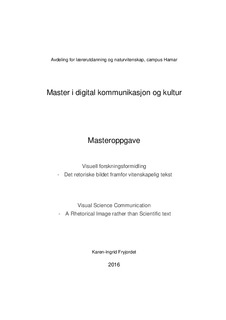Visuell forskningsformidling - Det retoriske bildet framfor vitenskapelig tekst
Master thesis
Permanent lenke
http://hdl.handle.net/11250/2406685Utgivelsesdato
2016Metadata
Vis full innførselSammendrag
Norsk:
I denne masteroppgaven ser jeg på hvordan vitenskapelig forskning formidles via visuelle
uttrykk som det bilder er. Caset i min masteroppgave er Forskning.no der jeg ser på hvordan
de bruker bilder for å formidle nyere forskning via sin nettavis. Forskning.no er i dag en av
landets fremste på å formidle forskning via en populærvitenskapelig sjanger som nettavis. Jeg
har samlet inn bilder fra to ulike uker høsten 2015, hvor datamateriale består av 83 bilder. Via
et råstudie har jeg registrert tendenser av egenskaper i bildene ute i fra de tre semiotisk
tegntypene ikon, indeks og symbol, samt identifisert bruken av de retoriske appellformene
ethos, pathos og logos. Den kvalitative dybdeanalysen har fått tildelt størst plass i denne
oppgaven, der ti bilder som utgjorde hovedoppslaget de ti dagene jeg gjorde datainnsamling
analyseres via det retoriske perspektivet.
Gjennom kvalitativ metode har jeg analysert hvilken retorikk bildene består av. Jeg har vurdert
bruken av bilder fra forskningsinstitusjoner eller som illustrasjonsfoto. Videre har jeg drøftet
om de framstår illustrerende eller dokumentariske til saken, basert på tegntyper og
konnotasjoner. Hvordan bildenes retoriske appellformer opptrer ser jeg også i sammenheng
med overskriften i forskningsartiklene. En fellesnevner for majoriteten av bildene i uke 43 og
45 hos Forskning.no var deres illustrerende funksjon og at bildene var forankringen i
overskriften. Meningsdannelsen i bildet ble både begrenset og fordypet på grunnlag av ett ord
i overskriften som var å finne som tegn i bildene. Via min analyse fant jeg ut at bildene ofte
ikke har en særegen funksjon i den unike forskningsformidlingen, og derav formidles ikke
forskningen via bildene. Bildene fungerer i stedet som representasjon for forskningen som
omtales, og som visuelt kommunikativt iøynefallende virkemiddel på nettsiden. Bildene har
høyest forekomst av logosappell og ethosappell, og i noe grad pathosappell. Ved lite bruk av
ikoniske og reelle avbildninger fra selve forskningsaktivitet eller funn, er det ikke forskning
som formidles i bildene, det er det selve teksten gjør. English:
In this Master Thesis, I look at how Scientific Research is communicated through Images as
Visual expression. The Case in my Thesis is Forskning.no where I look at how they use Images
in online communications of Research. Forskning.no is currently one of the leading websites
I Norway doing communicating Research through a popular science genre. In autumn 2015 I
collected Images from two different weeks, where my data includes 83 images. Of all these
Images I have been doing registered of tendencies of properties in pictures, based on three
semiotic types of signs; icon, index and symbol. I have further identified the use of the
rhetorical appeal forms ethos, pathos and logos. The depth qualitative analysis is mainly
concentrated in this task. Ten Images that constituted as the main Research article the ten days
I did data collection is analyzed based on the rhetorical perspective.
Through qualitative method, I have analyzed the rhetorical details in the Images. I have
considered the use of Images if their origin are from research institutions or illustration photos.
Furthermore, I discussed whether they appear illustrative or documentary, based on types of
signs and connotations. How the Images rhetorical appeal based on how they are acting, I see
in the context of the headline in Research articles. A major tendency in the Images in week 43
and 45 at Forskning.no, are their illustrative function and that the Images were anchoring from
the headline. Creation of meaning in the Images was both limited and deepened on words,
often only one, in the headline. These words I did find as a sign in the Image. Through my
analysis, I found that the Images often do not have a distinctive feature of the unique Science
communication, and hence not communicated Research through its Image. Instead, the Image
do only represent the Research discussed in the text and as visually communicative
conspicuous means on the website. The Images have the highest incidence of logo appeal and
ethos appeal, and some pathos appeal. In the absence of using iconic and real Images from
Research or Research findings, there is no act of Research communicated in the pictures. That
is what the text itself does.
Beskrivelse
Mastergradsoppgave i digital kommunikasjon og kultur, Avdeling for lærerutdanning og naturvitenskap, Høgskolen i Hedmark, 2016.
